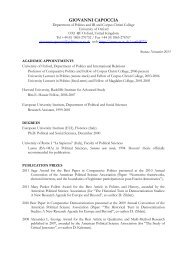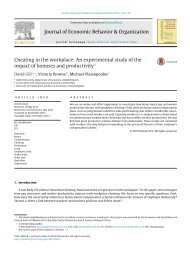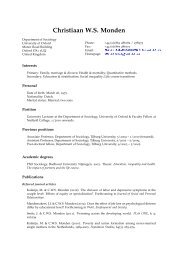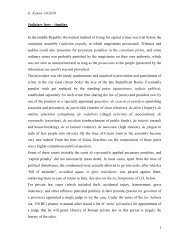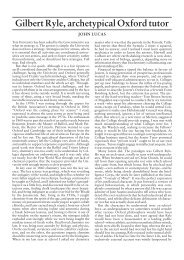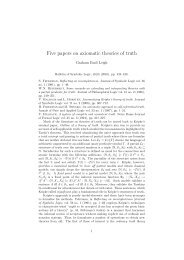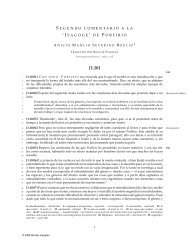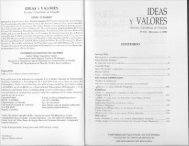KAPITEL 5 TRISTRAM SHANDY (1759–67) 5.8 PARATEXT IM TEXT 5.8 Paratext im Text In Tristram Shandy wird <strong>der</strong> Paratext auch im Text ständig durch den omnipräsenten Erzähler thematisiert. Dies ist die Folge <strong>der</strong> selbstreferentiellen Subjektivität und self–consciousness 57 von Tristram als Schreiber se<strong>in</strong>er Autobiographie, die er als se<strong>in</strong> persönliches Hobby–Horse, als ” unverb<strong>in</strong>dliche Spielwelt“ o<strong>der</strong> ” ästhetischen Raum“ begreift: ” Dieselbe Romanwirklichkeit, die sich <strong>in</strong> <strong>der</strong> Perspektive <strong>des</strong> an ihr scheiternden ’ Historikers‘ als e<strong>in</strong>e ” vom Dämon <strong>der</strong> Vergeblichkeit beherrschte Welt“ gibt, ersche<strong>in</strong>t <strong>in</strong> <strong>der</strong> <strong>des</strong> Steckenpferdreiters <strong>in</strong> spielerischer Leichtigkeit und Heiterkeit.“ 58 Das bloße Faktum <strong>der</strong> Schriftlichkeit und <strong>der</strong> damit verbundenen Setzung wird so aber für Tristram e<strong>in</strong> entscheiden<strong>des</strong> Problem, denn se<strong>in</strong> Gedankenfluß wi<strong>der</strong>setzt sich gerade <strong>der</strong> Sukzession von Zeichenketten, statt<strong>des</strong>sen bleibt se<strong>in</strong>e Autobiographie stets “work <strong>in</strong> progress”. 59 Tristrams Gedanken kreisen durch se<strong>in</strong>e Reflexionen, wie e<strong>in</strong>e Autobiographie am besten geschrieben werden könnte, <strong>des</strong>wegen nicht nur um die dargestellte Romanwelt, son<strong>der</strong>n auch um ihre Darstellungsmöglichkeiten, wozu auch das Mittel <strong>des</strong> Paratexts zählt: so s<strong>in</strong>d die Grenzen zwischen Text und Paratext fließend, wenn Tristram Ankündigungen über spätere Bände und Kapitel macht (Ende von II, xix [S. 122], die Angabe <strong>des</strong> Kontexts e<strong>in</strong>es Ban<strong>des</strong> <strong>in</strong> e<strong>in</strong>em Gesamtwerk ist eigentlich e<strong>in</strong>e Vorwortfunktion), über die verschiedenen Kapitel (“Upon chapters” IV, x [S. 225f.]), die er noch schreiben wird, reflektiert o<strong>der</strong> wenn <strong>in</strong> IX, xxv (S. 524) die Auslassung <strong>der</strong> Kapitel IX, xviii und xix (blank chapters [S. 512 und 513]) aus den Notwendigkeiten <strong>des</strong> plot und <strong>der</strong> Gleichberechtigung <strong>des</strong> sche<strong>in</strong>bar Unwichtigen und <strong>des</strong> sche<strong>in</strong>bar Signifikanten gerechtfertigt wird. 60 Tristram übt dadurch auch, wie Laurence Lerner beschreibt, Kontrolle über 57 Vgl. John M. Stedmond: “[Sterne] projects himself <strong>in</strong>to Tristram. However, Tristram is a most self–conscious narrator. Presumably, he is <strong>in</strong> part aware of his creator, Laurence Sterne, but this is only another way of say<strong>in</strong>g that, like Sterne, he is supremely conscious of the act of writ<strong>in</strong>g itself [. . . ]. He is conscious of the limits with<strong>in</strong> which he must work: not only the limits imposed by the materials of his chosen art–form, but the limits of what he is try<strong>in</strong>g to represent of the life of a man, <strong>in</strong>asmuch as he himself is conscious of that life.” In [53] Stedmond, S. 134. 58 In [54] Warn<strong>in</strong>g, S. 49. 59 Henri Fluchère faßt zur Romankonzeption Laurence Sternes zusammen: “Sterne is always conscious of what a strange th<strong>in</strong>g it is to write a book that will ultimately lead a separate existance of its own. The ‘fact of literature’ never ceases to be present to him, to astonish and amuse him, as if really it were one of the most astonish<strong>in</strong>g th<strong>in</strong>gs <strong>in</strong> the world to objectivize, page after page, day after day, the ever–new relationships between the world and himself, as figured forth by the mysterious written signs that represent language and meditation. [. . . ] From all this <strong>der</strong>ives that constant <strong>des</strong>ire to scandalize, that appetite that grows with what it feeds on and leads the narrator to juggle all the time with established ‘critical ideas’ [. . . ] [of a text and paratext, Ergänzung d. Verf.].” In [26] Henri Fluchère: Laurence Sterne: From Tristram to Yorick. An Interpretation of Tristram Shandy. Aus dem Französischen übersetzt und gekürzt von Barbara Bray. London: Oxford UP, 1965, S. 158. 60 Vgl. Henri Fluchère: “[T]here are neither little th<strong>in</strong>gs nor big th<strong>in</strong>gs: there is noth<strong>in</strong>g <strong>in</strong>significant, superfluous or redundant, nor on the other hand is there anyth<strong>in</strong>g that may predom<strong>in</strong>ate over the rest or claim to occupy the stage alone. It is not even certa<strong>in</strong> that Chapter XVIII has the right to come before Chapter XXV [. . . ] or that a completely empty chapter is worth less than one stuffed to the gills. This is only another way of say<strong>in</strong>g that the qualitative choice is made 97
KAPITEL 5 TRISTRAM SHANDY (1759–67) 5.8 PARATEXT IM TEXT die Rezeption <strong>des</strong> Texts aus, die erneut die enge Verknüpfung von Text und Paratext als e<strong>in</strong> Ganzes betont: “[I]nstructions can be wholly <strong>in</strong>side the text, to the po<strong>in</strong>t when it becomes impossible to excise them. We might [. . . ] say that metanarrative and all forms of self–consciousness about the tell<strong>in</strong>g of a story are <strong>in</strong>structions on how that story should be read [. . . ]. The self–consciousness of Tristram Shandy [. . . ] is so prom<strong>in</strong>ent that to remove it we would have to tear the book <strong>in</strong> half, and it might not be the worser half that we threw away.” 61 entirely accord<strong>in</strong>g to a dramatic necessity, only l<strong>in</strong>ked to an ever–chang<strong>in</strong>g mental activity.” In [26] Fluchère, S. 266. 61 In [35] Lerner, S. 256. 98



